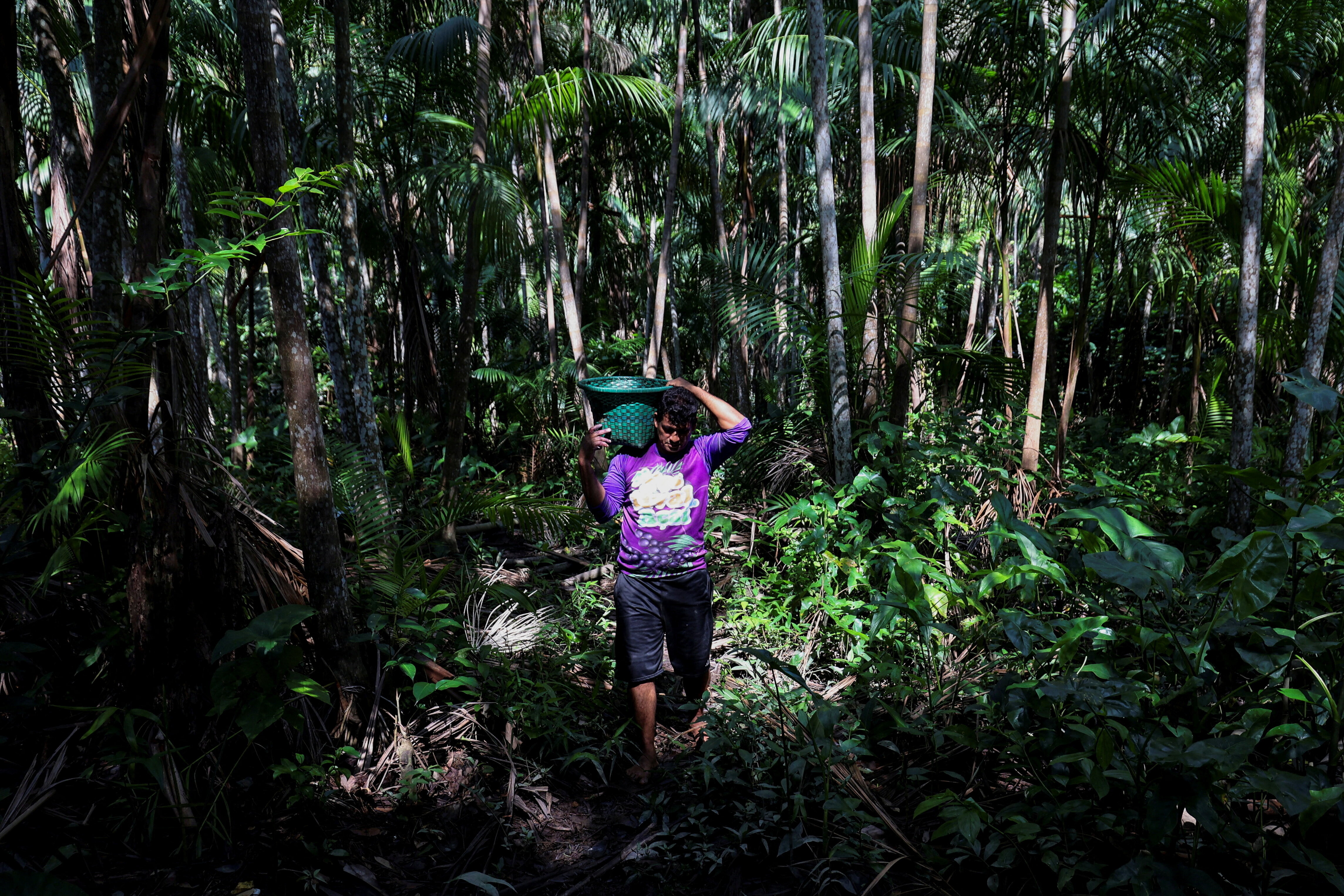Here's how we can rethink the way we eat meat

A plant-based hamburger produced in Redwood City, California. Image: REUTERS/Beck Diefenbach
By 2050, the world population is projected to reach nearly 10 billion. According to the Food and Agriculture Organization, food production must increase by 70% to feed this larger population. How we approach this gap in our growing food system will directly affect our health and the stability of our natural ecosystems.
According to PETA, it takes nearly 20 times less land to feed people a plant-based diet than it does to feed meat-eaters, as crops are consumed directly instead of being used to feed animals, which also need land.
Making the transition from mass-produced animal proteins to plant-based alternatives is not just necessary to meet population demands; the latter have also been linked with a smaller carbon footprint and a lower disease risk.
Several meat substitutes have been developed across the last decades and meat alternatives entirely made of vegetable components have gained market share.
The first generation alternative proteins are products based on soy, such as Tofu, Seitan and Quorn. The second generation alternatives are selling the value proposition of bringing to the market a product that bleeds, tastes and looks like meat. Insects are an additional source of natural proteins. In addition to sufficient minerals, they have a high protein content (Defoliart, 1992); their high bioconversion rate is favorable for large-scale production although processing requires to get rid of non-digestible chitin (Verkerk, Tramper, van Trijp, & Martens, 2007). Finally, the third generation alternatives is culturing meat based on stem cell technology, also called clean meat (Mark J. Post, 2012).
The ultimate goal is to create a more sustainable food system. In an effort to replicate the meat experience, we see that several companies are in the process of developing products that mimic the color, texture and taste of their animal-sourced counterparts. Many of these products can now be found on grocery-store shelves and restaurant menus throughout the United States and Canada.

Plant-based meats are constructed of plant-derived ingredients, but are designed to look and taste like real meat. Every company uses a different approach to create their own version. For example, Beyond Meat uses a proprietary system that applies cooling, heating and pressure to align plant proteins in the same fibrous structures that are found in animal proteins. This makes it look and cook like traditional meats like pork, chicken, and beef.
Cultured meat, meanwhile, is a fairly new concept that refers to the concept of meat, but is produced via cell structure, rather than from a slaughtered animal. According to the American Association for the Advancement of Science, the first generation of cultured meat will be available in the next five years.
The technology was developed as a sustainable way to produce animal-based proteins without having to sacrifice animals. The procedure requires the extraction of stem cells from a donor animal, which then proliferate to produce animal tissue structures. Unfortunately, meat culturing has presented challenges which have resulted in fairly slow uptake of the process.
While animal protein sources, such as meat, poultry, eggs, fish and dairy, are considered complete protein sources, containing all the amino acids needed for optimal bodily function, they are not without fault. According to Harvard T.H. Chan School of Public Health, production of animal-based foods tend to produce higher greenhouse-gas emissions than plant-based foods. These emissions could have a detrimental effect on the environment in years to come.
In an interview with Mark Post, professor at Maastricht University and Chief Scientific Officer (CSO) of Mosa Meat, during our Food Innovation Global Mission, he explains the financial and environmental consequences of sourcing animal-based proteins. “The fact is a lot of people want meat, and it’s a particularly expensive protein to make since a lot of resources go into it.”

But, from boerewors grilled during weekend barbecues in South Africa to slow-cooked tamales stuffed with pork on every holiday table in Latin America, meat remains an integral part of cultures across the globe. Not only is it a source of nutrition, the eating of meat touches everything from socialization to social status.
How we approach the development of sustainable proteins will differ from country to country, as traditional meats are not able to be easily replicated by all cultures. For example, meat culturing is being pushed in Asian countries as most culturally consumed foods are difficult to reproduce using plant-based ingredients. “In countries like the US or UK, a plant-based burger will do,” says Yuki Hanyu, CEO of ShojinMeat in Japan. “But in countries like France, Japan and China, it can’t really stimulate meat dishes like Peking duck or yakitori.”
But the increasing impact of meat is expected to only grow more detrimental in the decades to come. Providing plant-based alternatives is a viable solution for reducing our dependence on animal proteins. It’s not enough, though, to produce sustainable plant-based alternatives, but to alter human perception so that more people are willing to make the change. “Instead of pushing people towards a more plant-based diet, by creating stronger alternatives, you would be able to naturally pull them towards it,” says David Benzaquen, founder and CEO of PlantBased Solutions. “You make something desirable, so people want in.”
Most consumers already know that eating plant proteins is a smart way to avoid cholesterol, saturated fat and common allergies to eggs and dairy. People are also consuming more plant foods and less animal proteins as a way to avoid hormone and antibiotic residues found in meat. While change in the food industry is inevitable, it will come easier to some than others. Companies’ ability to replicate the unique flavor and texture of meat will have a direct effect on consumers’ decision to make healthier and more sustainable food choices.
As more people start to adapt plant-based diets, alternative protein sources will grow faster and more steadily. In the future, plant-based proteins may dominate over meat and seafood. Of course, that doesn’t mean that the whole world needs to convert to vegetarianism to reap the benefits of a plant-heavy diet.
Moderation in the consumption of meats, in addition to portion control, can be highly advantageous for our health and the stability of our natural ecosystems. Making fresh fruits and vegetables more accessible and affordable can also positively effect change. Ideally, we want to promote a human diet that provides consumers with the great taste and nutritional value of animal-derived foods, without the negative health and environmental impact.
Don't miss any update on this topic
Create a free account and access your personalized content collection with our latest publications and analyses.
License and Republishing
World Economic Forum articles may be republished in accordance with the Creative Commons Attribution-NonCommercial-NoDerivatives 4.0 International Public License, and in accordance with our Terms of Use.
The views expressed in this article are those of the author alone and not the World Economic Forum.
Stay up to date:
Food Security
Forum Stories newsletter
Bringing you weekly curated insights and analysis on the global issues that matter.







